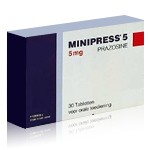Breaking the Pressure Cycle: A Deep Dive Into Arterial Hypertension


Arterial hypertension, more commonly known as high blood pressure, is one of the most widespread chronic medical conditions affecting millions of people worldwide. Despite its prevalence, the condition is often underestimated until it begins to cause serious complications. Hypertension is frequently referred to as a “silent killer” because it develops gradually and rarely causes obvious symptoms until significant damage has occurred. Understanding its causes, the difference between arterial and pulmonary hypertension, classification systems, potential risks, and treatment options — including the role of medications such as Minipress (prazosin) — is crucial in both prevention and management.
What Is the Main Cause of Arterial Hypertension?
The development of arterial hypertension is complex and multifactorial. In most cases, there is no single identifiable cause, which is why the majority of patients are diagnosed with primary (essential) hypertension. This form is influenced by a combination of genetic predisposition and lifestyle factors.
Genetics plays a significant role: individuals with a family history of hypertension are more likely to develop it themselves. However, environmental and lifestyle influences often determine whether the predisposition manifests. Among these, the most significant contributors are excessive salt intake, obesity, lack of physical activity, chronic stress, and excessive alcohol consumption. These factors increase peripheral vascular resistance or affect the kidneys’ ability to regulate sodium and water balance, both of which raise blood pressure.
A smaller proportion of patients develop secondary hypertension, which has an identifiable underlying cause. Conditions such as chronic kidney disease, endocrine disorders (including hyperthyroidism, Cushing’s syndrome, or primary aldosteronism), obstructive sleep apnea, or the long-term use of certain medications like corticosteroids can directly elevate blood pressure. Although less common, secondary hypertension tends to be more severe and may require targeted treatment of the underlying disease.
Arterial Hypertension vs Pulmonary Hypertension
While the term hypertension is broadly used to describe elevated blood pressure, it is important to distinguish arterial (systemic) hypertension from pulmonary hypertension.
Arterial hypertension refers to increased pressure in the systemic arteries — the vessels responsible for delivering oxygen-rich blood from the heart to the rest of the body. It is typically measured with a standard blood pressure cuff, producing the familiar systolic and diastolic readings. When these values consistently exceed 140/90 mmHg (according to many guidelines), arterial hypertension is diagnosed.
Pulmonary hypertension, by contrast, refers to elevated pressure in the arteries of the lungs. This condition is not detected through routine blood pressure measurement, since it involves the pulmonary circulation rather than the systemic one. Pulmonary hypertension is often associated with heart or lung diseases, such as chronic obstructive pulmonary disease (COPD), interstitial lung disease, or left heart dysfunction. While both conditions involve elevated pressures in arterial systems, their causes, manifestations, and treatments are entirely different. Pulmonary hypertension often presents with shortness of breath, fatigue, or chest pain and can progress to right heart failure, whereas arterial hypertension primarily threatens organs such as the heart, brain, and kidneys.
Arterial Hypertension Classification
Classifying arterial hypertension helps clinicians assess severity, predict complications, and guide treatment strategies. The most common classification system is based on blood pressure values, which are typically measured in millimeters of mercury (mmHg).
- Normal blood pressure: below 120/80 mmHg.
- Elevated (pre-hypertension): systolic 120–129 mmHg and diastolic below 80 mmHg.
- Hypertension Stage 1: systolic 130–139 mmHg or diastolic 80–89 mmHg.
- Hypertension Stage 2: systolic at least 140 mmHg or diastolic at least 90 mmHg.
- Hypertensive crisis: systolic over 180 mmHg and/or diastolic over 120 mmHg, requiring urgent medical intervention.
Another way of classifying hypertension considers whether it is primary or secondary, as discussed earlier. Beyond these, some specialists also categorize hypertension by target organ involvement, such as whether there is evidence of left ventricular hypertrophy, kidney damage, or retinal changes. This helps distinguish uncomplicated hypertension from more advanced stages with organ damage.
How Serious Is Arterial Hypertension?
The seriousness of arterial hypertension lies in its long-term effects on vital organs. Persistent elevation of blood pressure damages blood vessels, leading to atherosclerosis (hardening and narrowing of the arteries). Over time, this increases the risk of heart attack, stroke, and peripheral artery disease. The heart itself suffers from chronic overload, often resulting in left ventricular hypertrophy and eventually leading to heart failure.
The kidneys are also particularly vulnerable. Hypertension is a leading cause of chronic kidney disease, as the delicate vessels in the kidneys become damaged and lose their ability to filter blood effectively. The eyes can be affected too, with hypertensive retinopathy leading to vision problems or even blindness.
What makes the condition especially dangerous is its silent progression. Many patients live with hypertension for years without experiencing any clear symptoms, only to develop a life-threatening complication suddenly. This is why regular blood pressure checks are essential, even for those who feel healthy. Early detection allows lifestyle modifications and treatment before irreversible damage occurs.
Treatment Strategies and the Role of Lifestyle
Managing hypertension often begins with lifestyle changes, especially for those with Stage 1 hypertension or individuals at risk. Reducing sodium intake, losing weight, engaging in regular physical activity, limiting alcohol, and quitting smoking are all proven to lower blood pressure. Stress management techniques such as meditation, deep breathing exercises, and adequate sleep also contribute to overall cardiovascular health.
However, for many patients, lifestyle modifications alone are not sufficient, particularly in more advanced cases. Here, medications become necessary. The main classes of antihypertensive drugs include diuretics, beta-blockers, calcium channel blockers, angiotensin-converting enzyme (ACE) inhibitors, and angiotensin II receptor blockers (ARBs). Each class works differently, and often a combination of drugs is required to achieve optimal control.
The Role of Minipress in the Treatment of Hypertension
Among the less frequently used but still important classes of antihypertensive medications are alpha-adrenergic blockers, with Minipress (prazosin) being one of the best-known representatives.
Minipress works by relaxing the smooth muscle in the walls of blood vessels through selective blockade of alpha-1 adrenergic receptors. This reduces vascular resistance and, consequently, lowers blood pressure. Unlike diuretics or ACE inhibitors, which affect fluid balance and hormonal pathways, Minipress acts directly on the tone of the blood vessels.
Minipress is particularly valuable in certain clinical contexts. For example, it can be used in patients with hypertension who also suffer from benign prostatic hyperplasia (BPH), since it alleviates urinary obstruction symptoms by relaxing the smooth muscle of the prostate and bladder neck. It may also be prescribed when patients do not tolerate first-line antihypertensives or require additional blood pressure control despite other medications.
However, Minipress is not typically a first-line treatment for hypertension. Its use may be limited by side effects such as dizziness, headaches, or a sudden drop in blood pressure after the first dose — a phenomenon known as “first-dose hypotension.” For this reason, careful dose titration and patient education are essential. Nevertheless, in the right clinical context, Minipress remains a useful part of the antihypertensive arsenal.
Preventing Complications Through Long-Term Management
Effective control of hypertension dramatically reduces the risk of severe outcomes. Studies consistently show that lowering blood pressure decreases the incidence of stroke, myocardial infarction, and kidney disease. This highlights the importance of adherence to treatment, both in terms of lifestyle and medications.
Patients need ongoing monitoring, since blood pressure levels can fluctuate with stress, illness, or changes in weight and activity. Adjustments to treatment plans are common, and long-term success depends on regular checkups and patient engagement. Educating patients about the silent but serious nature of hypertension is equally vital, ensuring they understand why strict control is necessary even when they feel fine.
Conclusion
Arterial hypertension is a widespread and serious medical condition that poses a significant threat to global health. Its primary causes are rooted in genetics and lifestyle factors, while secondary forms point to underlying medical disorders. It must be carefully distinguished from pulmonary hypertension, which involves the lung circulation and has different causes and treatments. Classification of hypertension helps in assessing severity, guiding treatment, and predicting risks.
Although often silent in its early stages, hypertension can lead to devastating complications if left untreated. Lifestyle changes are the foundation of prevention and management, but many patients require medications. Among the pharmacological options, Minipress (prazosin) has a defined though specific role, particularly in patients with coexisting conditions like benign prostatic hyperplasia or when additional therapy is needed.
Ultimately, the seriousness of arterial hypertension underscores the importance of awareness, early detection, and consistent treatment. By combining preventive strategies with effective medical management, individuals can significantly reduce their risks and maintain a healthier, longer life.
Drug Description Sources: U.S. National Library of Medicine, Drugs.com, WebMD, Mayo Clinic, RxList.
Reviewed and Referenced By:
Dr. Alan Carter, PharmD Clinical pharmacist with expertise in cardiovascular pharmacology and antihypertensive therapy. Frequently cited on Drugs.com for reviewing therapeutic guidance on medications including alpha-blockers like Minipress (prazosin).
Dr. Carol DerSarkissian, MD Board-certified in internal medicine, contributor to WebMD. Her clinical reviews focus on the management of hypertension, cardiovascular risk factors, and preventive strategies for long-term health.
Dr. Dianne B. McKay, MD Professor of Medicine, Division of Nephrology, Scripps Clinic. Contributor to NIH resources. Provides authoritative insight into the renal consequences of long-standing hypertension and therapeutic strategies to preserve kidney function.
Dr. William C. Shiel Jr., MD, FACP, FACR Chief Editor at MedicineNet and affiliated with WebMD. Has authored comprehensive content on hypertension classification, treatment guidelines, and complications involving the heart, brain, and vascular system.
Dr. Suzanne R. Steinbaum, DO Cardiologist, Fellow of the American College of Cardiology, and national spokesperson for the American Heart Association. Recognized for her expertise in women’s cardiovascular health, prevention, and hypertension management.
(Updated at Sep 27 / 2025)

